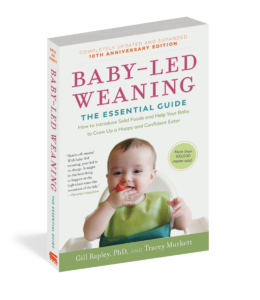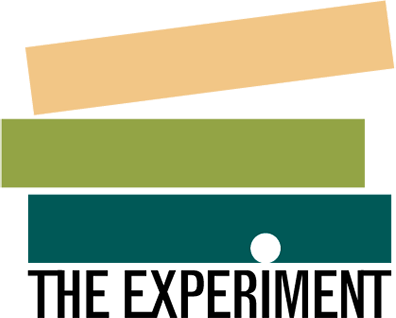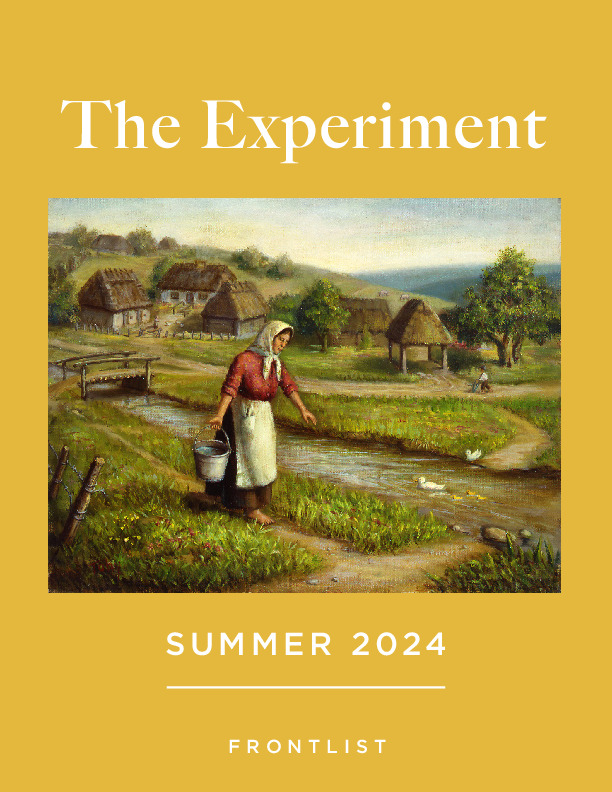Ten years ago, coauthors Gill Rapley and Tracey Murkett exploded the myth that babies need to be spoon-fed with the first edition of Baby-Led Weaning, starting what has become a worldwide movement. Baby-led weaning (BLW) shows why self-feeding from the start of the weaning process is the healthiest way for babies to develop; after all, at about six months, most babies are ready to discover solid food for themselves!
Today, BLW is a global phenomenon. With the publication of the 10th anniversary edition of Baby-Led Weaning, we decided to sit down with Rapley and Murkett to learn how this movement took off, how it’s changed in the last ten years, and what parents still need to know when it comes to BLW.
Q: Before Baby-Led Weaning became a favored technique among parents, the standard method of feeding involved baby food and purees. What inspired you to try self-feeding and start the BLW movement?
Gill Rapley: During the years 20+ I worked as a health visitor I saw many parents and their babies struggling with the introduction of solid foods. The more I saw and heard, the more I became convinced that what the babies were objecting to wasn’t the food itself but being fed by someone else. They were much happier, and ate a wider variety of foods, when they were allowed to feed themselves than when they were being spoon fed. Then, when research showed that the vast majority of babies under six months really didn’t need anything other than breastmilk or formula and that, once they reached that age, they were capable of feeding themselves and chewing, I began to question the whole approach to introducing solid food.
Tracey Murkett: When my daughter was coming up to six months, I started to wonder how to introduce solids. I had friends who used points and rewards to get their toddlers to eat, and others whose kids ate a very limited range of foods or wouldn’t even touch some foods. I remember thinking: It can’t be natural that something as basic as eating should be so stressful and difficult. Why are there so many problems? So, when I overheard some mums talking about baby-led weaning I was intrigued. They’d heard about it from Gill’s first ever talk about BLW and were trying it out. It sounded amazing – the two mums and their babies (just a month or two older than mine) had been for lunch at a Spanish restaurant and had all shared the same selection of tapas. The babies loved handling the food themselves and the mums were relaxed, and simply ate alongside their babies. It sounded so enjoyable for the babies, and so easy for their mums. When I started BLW with my daughter, she was so happy playing with food and (eventually) figuring out how to eat it, it was obvious it was a really natural, common-sense approach. I looked at her and thought: This is it! This is what babies are supposed to do!
Q: When you first started developing your theory of BLW, what were the reactions you received? Were parents initially skeptical of your feeding technique?
GR: Parents were the least skeptical! They only had to see BLW in action to ’get’ it, and they saw an immediate difference in the response of their babies to food. Many said this is what they had done instinctively but, because it didn’t have a name, they hadn’t spoken about it. With a few notable exceptions, health professionals have taken longer to convince than parents.
TM: When I first heard of BLW I knew right away it was going to change the way babies are fed. My daughter, Seren, is almost 14 now, so there weren’t very many people doing BLW when she was a baby. I got to know a few other BLW families and it was great fun watching how each baby progressed at their own pace and in their own unique way. But when we were eating out, we’d find people staring at her tucking into the food from our plates as if she was exceptionally advanced for her age or we’d taught her a special trick! My mother-in-law was skeptical at first, and worried about choking, but as soon as she saw Seren with food she could see how it worked, and then wondered why she had ever spoon fed her own kids.
Q: And now it’s a massive trend! Your original Baby-Led Weaning book was published a decade ago, and it’s still making waves in the parenting world. What is it about BLW that parents like so much?
GR: They like the fact that the whole family can eat together and that their baby gets enjoyment out of food. They also like that they don’t have to spend hours preparing separate food for their baby and that there is no need to resort to tricks and subterfuge to persuade their baby to eat vegetables.
TM: Parents really appreciate the fact that’s it so easy and stress-free, and feels so natural. They love watching their baby learn so much and develop new skills. It’s also a huge bonus that BLW encourages such a healthy relationship with food, and avoids mealtime battles.
Q: Which brings us to our next point: You’re about to publish your 10th anniversary edition of BLW! What has changed in the world of Baby-Led Weaning since you first originated the theory?
GR: There have been two key changes. The first is that BLW has exploded worldwide. It is now talked about in many different countries as a viable alternative to spoon feeding. The other is that researchers have begun to look into it, so that evidence is accumulating to support BLW as a sound, healthful approach that has many benefits.
TM: In the UK (and increasingly in other countries) many health professionals who work closely with parents now encourage BLW over spoon feeding because they have seen the results: toddlers with healthier attitudes to food and parents with less controlling behavior around food. Government guidelines on introducing solids now include key elements of BLW, such as allowing the baby to play with food, self-feeding and allowing the baby to decide how much to eat. Parents are no longer advised to spoon feed purees to a preset timetable, but are given information about self-feeding and spoon-feeding, so they can make a choice. All of this was unthinkable a decade ago, when all the information given to parents was based on the abilities of babies of four months old, even though the evidence was available that they shouldn’t start solids before around six months.
Q: In your new 10th anniversary edition of BLW, you expand the research to address several new topics, ranging from allergy prevention to feeding in nurseries. This revised edition provides the latest information for parents, but is also a highly informative read for pediatricians and caregivers. Do you have an ideal audience in mind for the book?
GR: Our book is aimed mainly at parents. They deserve to know about this approach, and to understand how to implement it, without waiting to be told about it by a health professional. Before the book was written BLW was already being discussed between parents, especially via the Internet, so it was clear that parents were the driving force that was spreading information about the concept. By writing for parents we also hoped to acknowledge and empower those who had discovered this approach for themselves, legitimizing what they were doing by giving it a name and a theoretical basis.
TM: Everyone is able to learn something new from this book, whether they’re a parent, a pediatrician, or a caregiver … There isn’t any other guide to BLW that has the same depth of information as our book, simply because we have been working on BLW for so many years, and pioneered the approach. We have spent more than a decade sharing ideas with parents and health professionals, so we know the questions that parents need practical answers to. We also have the best grasp of what the latest research means. So, ours is the go-to book for caregivers and health professionals, along with the core audience of parents, and we have expanded some of the sections to reflect this.
Q: Why do you think the myth that babies need to be spoon-fed has persisted for so long?
GR: Spoon feeding has long been associated with feeding babies because for many years it was believed that babies begin to need complementary (or ’solid’) food several months before they are able to chew, or to feed themselves. These skills develop at around six months so, for a baby younger than this, any solid food must be pureed and fed by spoon. However, we now know that babies under six months don’t need anything other than breastmilk (or formula), and that giving other foods earlier than this can lead to health problems.
Prior to 2002, the WHO’s recommended age for starting solid food was 4-6 months, in line with the research available at that time (although, in practice, many babies were given solid foods well before four months!) In 2002, the WHO changed their recommendation to ’around 6 months’ but they did not comment on the fact that the developmental difference between a four-month-old baby and a six-month-old meant that the way the foods were introduced could change too. The result was that the ’when’ changed but the ’how’ continued to reflect the abilities of a baby of four months. In the USA, the recommendation remained at 4-6 months for several more years, so the expectation of spoon feeding has continued to be widespread.
Together with the belief that solid food was needed from around four months was the belief that babies need to learn to take food from a spoon before they can be offered foods that require chewing, and that pureed foods help them to develop chewing skills. Neither of these things is true. Babies develop the ability to chew from around six months, whether or not they have been spoon fed. We only have to look to the many cultures that don’t use spoons to know that this is true. And there is evidence that reliance on pureed food can actually hamper the development of chewing.
It cannot be a coincidence that, at the age when babies begin to need to expand their diet beyond breastmilk, they are capable of picking up pieces of food, taking them to their mouth, and chewing. It is hard to justify any need for spoon feeding when this is the case. Learning to take food from a spoon is a skill that can be learned later, rather than being thought of as necessary in order for the child to eat solid food. We need also to remember that many cultures don’t use spoons, with no apparent detriment to their babies’ development.
TM: Another factor is that baby food manufacturers continue to work hard to encourage parents to believe that babies need solid food well before six months, and that being spoon fed purees is an essential stage in a baby’s life. This is why commercially-made baby food is still often labelled as suitable from four months even though there has been evidence for many years that it can be harmful before six months.
Spoon feeding is simply left over from when it was believed that babies needed solid food before they were able to feed themselves. The current evidence-based guidelines recommend offering solid food from around six months, by which time typically developing babies have matured enough to have the strength and coordination to pick food up and take it to their mouth. Spoon feeding is not necessary at this age, and may even prevent babies from learning the skills associated with self-feeding at the most appropriate time.
Q: …and why Baby-Led Weaning is, in fact, the healthier and easier way to feed a baby?
GR: Available evidence suggests that babies have a natural ability to recognise their own nutritional needs and to respond to appetite and satiety signals. Giving them control over what they eat (from a range of healthy foods), how much and how fast seems to nurture this ability. In contrast, spoon feeding may encourage them to override it. We also know that persuading kids to eat certain foods and/or restricting the foods they are allowed encourages the development of an unhealthy relationship with food. BLW is also thought to help the development of the mouth, reducing the need for orthodontic treatment and aiding speech development.
TM: It much easier to simply share your own food and eat together with your baby, rather than spend time making up purees, or rely on commercially made, highly-processed baby food. We have heard countless families say they have changed their own diets (for example by reducing salt use) to make sure the food they share is as healthy as possible for their baby. So adults and older children are also benefiting from BLW. Sharing family mealtimes is a hugely important way for babies to learn language and social skills, and handling food encourages the development of fine motor skills and hand-eye coordination.
Q: Perhaps the biggest concern that parents have about BLW is that it will increase the risk of choking. Could you explain why parents shouldn’t worry about this? Are there any other myths you’d like to dispel?
GR: Research has shown that this approach presents no greater risk of choking than spoon feeding. In fact, there is good reason to believe that sucking food into the mouth, lack of control over the pace of eating, and distraction while eating – all features of spoon-feeding – actually increase this risk. Baby-led weaning requires that the baby is sitting upright, is the only person to put food into his mouth, is not hurried while eating, and is not offered foods that are known to be a choking risk. These features help to keep babies safe.
Another myth I should like to dispel is that BLW is a new idea. It isn’t. Parents have been doing it for eons. All that is new is that it has a name, which has enabled it to be discussed and debated. Even if it were new, it’s now over a decade since our book was first published, and many thousands of babies all over the world have started solid food this way – if it presented a higher risk of choking that would have been established long ago.
A third myth is the idea that BLW is only suitable for typically developing babies. It may need to be adapted for babies with developmental delay, physical disabilities or certain medical conditions, but the underlying principle of respecting the baby’s appetite and supporting her/him to be as autonomous as possible can be extended to all infants.
TM: One of the myths that seems very popular at the moment is that it’s possible to do ’a bit of both’, i.e. combine elements of BLW with spoon feeding, and still have the benefits of BLW. This usually means the baby is allowed to feed himself and share family food but is then topped off with some puree from a spoon to make sure he has eaten the adult’s idea of ’enough’. This undermines one of the fundamental principles of BLW – that the baby is trusted to control his own intake and decide for himself when he has had all he needs. Topping him off with puree overrides his natural sense of fullness, encouraging him to overeat, long term. It also means that he is likely to be too full to take as much breastmilk or formula as he would otherwise have done at his next milk feeding, meaning that a highly calorific and nutritious food has been replaced with, say, some mashed carrot. Over time, persuading the baby to take more solid food than he needs is likely to hasten the reduction of milk feedings and may mean that they are phased out too soon.
In reality, the ’bit of both’ approach is not very different from introducing solids the conventional way, which has always included the introduction of finger foods from around six months, along with purees. ’Parent-led’ and ’baby-led’ can’t be combined without losing the key benefits of being truly baby-led.
Q: And finally: what is the #1 thing you want parents, pediatricians and other childcare-oriented readers to take away from your 10th anniversary edition of Baby-Led Weaning?
GR: That BLW is not a passing fad. It is a long-standing approach based on sound reasoning and common sense. Research is revealing it to be safe and to contribute to healthy food choices and it is slowly being incorporated into guidelines for parents for the introduction of solid foods. It is here to stay.
TM: Baby-led weaning is the most healthy, enjoyable and natural way to start solids with babies. Spoon-feeding and purees will soon be a thing of the past.
***
Interview with Gill Rapley, PhD and Tracey Murkett, authors of Baby-Led Weaning: The Essential Guide—How to Introduce Solid Foods and Help Your Baby to Grow Up a Happy and Confident Eater: Completely Updated and Expanded Tenth Anniversary Edition
(The Experiment, July 2019); theexperimentpublishing.com.





